IDŐJÁRÁS - angol nyelvű folyóirat
Vol. 124, No. 3 * Pages 311–426 * July - September 2020
 |
|
 letöltés [pdf: 3459 KB]
letöltés [pdf: 3459 KB]
Parameter estimation and threshold selection uncertainty in extreme wind speed distribution – A frequentist approach with generalized Pareto distribution using automatic threshold selection
Ágnes Kenéz and Attila László Joó
DOI:10.28974/idojaras.2020.3.1 (pp. 311–330)
Ágnes Kenéz and Attila László Joó
DOI:10.28974/idojaras.2020.3.1 (pp. 311–330)
IDŐJÁRÁS folyóirat

Az IDŐJÁRÁS a HungaroMet Nonprofit Zrt. negyedévenként megjelenő angol nyelvű folyóirata
Megrendelhető a journal.idojaras@met.hu címen.
A szerzőknek szánt útmutató itt olvasható.
Megrendelhető a journal.idojaras@met.hu címen.
A szerzőknek szánt útmutató itt olvasható.









